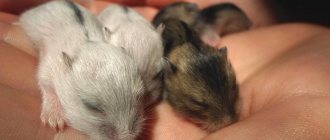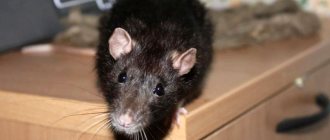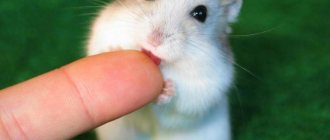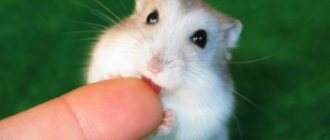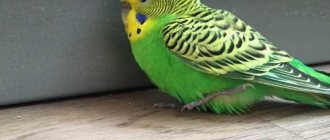Around 100,000 rat attacks on people are recorded annually around the world. Moreover, according to official statistics, only one rat bite out of 36 becomes known to health authorities and is included in these very statistics. That is, in fact, every year up to 3.5 million people around the world become victims of rat attacks, a significant part of which are children.
Perhaps the first thing to keep in mind is that if you or your child are bitten by a rat, there is no need to panic: it is not fatal, and the likelihood that a bite will cause infection with a dangerous disease, although possible, is very small. In addition, with the help of fairly simple actions, the risk of developing undesirable consequences after a rat bite can be minimized - we will talk about this in more detail below.
On a note
However, even without infection of the wound, a rat can cause serious injury with its sharp teeth. There are cases when these animals bit off a piece of a person’s ear and even broke a finger (crack in the bone). And in especially impressionable victims, a sudden rat attack can cause the development of phobias and various nervous disorders that can accompany a person for years, sometimes for the rest of his life. This is especially true for children.
So, let's see what needs to be done immediately if a rat bites, that is, literally in the first minutes after the rodent attack - the possible consequences of the bite largely depend on how correctly and quickly the appropriate actions are taken...
First actions after a rat bite
The first thing to do after a rat bite is to wash the wound with water and treat it with any highly effective antiseptic. To do this, you can use, for example, an alcohol solution of iodine, brilliant green, hydrogen peroxide, Miramistin or Chlorhexidine.
Since rats often bite until they bleed, and the wound can be quite deep, treatment should be carried out without waiting for the bleeding to stop. The wound should be treated carefully, including even minor scratches - this will be reliable protection against infection. After this, it is useful to bandage the bite site for at least a few hours to prevent mechanical damage to the wound and contamination from the outside (if this is not done, the risk of wound suppuration in the future increases).
On a note
If a rat has bitten a small child, he must first be calmed down. You can joke, remember a cartoon character, tell what kind of hero the baby has now become. It is also useful to shift the emphasis and say that the animal was afraid of the big boy (girl) and therefore bit. Otherwise, the child will believe that all rats are aggressive and very dangerous, and this is a direct road to a phobia.
Remember: the sooner the baby calms down and is distracted, the lower the risk of developing psychological consequences of the incident. And in the case of very impressionable adults (especially women), this step should not be ignored - without emergency psychological help, the bitten person may become hysterical and even faint.
In general, after a rat bite, you should not get hung up on thoughts about possible dangers and infections. Although the popular belief is that rat saliva is a broth with microbes and viruses, in reality, disease infections from rodent bites occur rarely, mainly in conditions of total unsanitary conditions in third world countries.
Meanwhile, although the bite most likely will not have any serious consequences, it is nevertheless worth monitoring the condition of the wound, and at the first sign of a complication, consult a doctor. Moreover, the most dangerous consequences of rat bites do not develop immediately, but several days (or even weeks) after the animal’s attack, when the wound has already completely healed.
On a note
Special studies have shown that even if you do nothing after a rat bite to disinfect the wound, the risk of contracting an infectious disease during an animal attack does not exceed 2%. Even after simply washing the wound, opportunistic or pathogenic bacteria were found in it only in 30% of cases, of which in 43% of cases these bacteria were staphylococci, which normally do not pose a health hazard and are always found on the surface of the human body. Treating a bite with an antiseptic can destroy almost all bacteria in damaged tissues. In other words, if you do simple but timely treatment of the wound, this will almost completely eliminate the risk of infection from a rat bite.
Still, it is useful to know what consequences rat bites can sometimes cause. If you are aware, you will be able to figure out what to do in a particular situation...
First aid to the victim
If an encounter with a rat ends in a bite, it is important to properly provide first aid to the victim of aggression. However, you should not stop the bleeding immediately.
Harmful microorganisms will come out of the wound along with the blood, which will reduce the risk of infection.
It is best to squeeze out enough blood yourself. Rats have very thin teeth, and the punctures in the skin are deep and thin. As a result, the layer of skin quickly tightens, and the blood does not always have time to wash out most of the microbes that have entered the wound.
Mandatory actions immediately after a bite will be:
- washing the wound with a solution of laundry soap (1/3 bar per 2 cups of warm boiled water);
- treating damaged areas of the epidermis with 3% hydrogen peroxide or chlorhexidine, lubricating the edges around the bite with iodine or brilliant green;
- maximum opening of the wound and placing antibiotic ointment (levomekol) inside;
- Applying a cotton swab and a clean bandage to the affected area.
If a superficial wound forms, washing with laundry soap for 5 minutes will be sufficient. Deep damage must be treated twice as long. To do this, pour the prepared solution into a pear and wash the affected area with light pressure.
“Timely first aid can reduce the likelihood of infection by more than 60%, and treating the wound with antiseptics helps destroy almost all bacteria and eliminate the risk of pathogens from the animal’s saliva entering the human blood. After being bitten by a wild rat, it is recommended to visit a doctor to ensure there is no infection.”
Possible consequences of rat bites
As noted above, a rat bite is dangerous, primarily due to the risk of contracting infectious diseases. Such infections are rare, but the infections themselves can be quite serious (and deaths after infection are a good enough reason to closely monitor the condition of the victim).
A rat bite itself can cause the following diseases:
- Sodoku, which is called “rat bite disease.” According to statistics, if sodoku is not treated, then in approximately 10% of cases it leads to the death of the patient. However, if therapy is started on time, a person is cured quickly and completely;
- Tetanus is a dangerous disease that requires the most intensive therapy. Every year, from 30 to 60 thousand people die from it around the world, mostly children, and the mortality rate is very high - about 20-25%. According to this indicator, tetanus is among the three most deadly infectious diseases after rabies and pneumonic plague. Complications of this disease are also dangerous - cardiac paralysis, pneumonia, sepsis. Tetanus develops extremely rarely from rat bites, but the risk is present;
- Leptospirosis is transmitted from rats more often than other infections, and the susceptibility of people to its pathogen is very high. The disease is severe and in half of the cases requires treatment in intensive care units. Among its complications are paralysis, myocarditis, acute renal failure, infectious-toxic shock;
- Pseudotuberculosis (yersiniosis), the main danger of which is the possible development of complications - meningitis, polyarthritis, osteomyelitis and myocarditis.
It is also useful to read: Why are rats dangerous to people and what diseases do they carry?
But it is almost impossible to become infected with rabies from a rat bite. There are literally only a few such cases known, and in each of them it was impossible to reliably state that the infection occurred specifically from rodents.
It is worth considering that opportunistic bacteria can get into the wound itself, which sometimes leads to inflammation and suppuration. If the victim is shown to a doctor, this situation is not dangerous: the abscess can be opened and drained, and then its cavity can be disinfected.
Such ulcers pose a threat if they are neglected - they can develop into ulcers (especially in hot and humid climates), abscesses and gangrene. And these consequences, in turn, are fraught with blood poisoning or the need for limb amputation. Today this happens extremely rarely.
In addition, it is important to understand the following pattern: if a rat bites a person, it means that it lives next to him. And the fact of such proximity is often no less dangerous than the bite itself. Most infections from rats are transmitted through the nutritional route - through soiled and contaminated food, water, and household items. And even if infection does not occur during a bite, it can happen at any other moment, when a person does not see or hear the rodent, but eats, for example, bread that the pest has already undermined at night. Moreover, infections from rats are transmitted in this way much more often than directly through bites.
On a note
It is because of the proximity of rats that several hundred million people have died in the entire history of human civilization - more than in the bloodiest wars combined. Animals simply physically could not have eaten so many people, but the fleas living in the fur of rats could (it was these blood-sucking parasites that infected people with the plague). And today all these problems have not gone away: several thousand people die from the plague every year in the world, and besides it, fleas carry typhoid, anthrax and other diseases from rats.
Another danger is the injury itself from the bite. It would seem that it is unlikely that an animal weighing about 100-200 grams can seriously injure a person. It turns out it can. For example, there are widely known cases of rats biting off the earlobes of sleeping people, gnawing the skin on the heels to the flesh, and biting through the wings of the nose. Moreover, such injuries occur more often in children than in adults.
Here are the dry statistics:
- 62% of rat bites are simply small wounds;
- 14% of bites are lacerations up to 1 cm long;
- 12% - abrasions;
- 6% - bruises under the skin;
- 5% - hematomas;
- less than 1% - fractures (finger fractures were recorded).
The photo below shows an example of a rat bite:
And in this photo there is an ear with a scar after an animal attack:
In practice, in most cases, rats bite people on the hands, less often on the legs, and even less often on the face. This confirms the fact that most often rats do not bite without a reason, but use their teeth only for self-defense when they are trying to catch them.
A rat can also bite a sleeping person. In slums and poverty-stricken areas of cities in developing countries, most attacks by these animals involve bites of sleeping people. In developed countries, the number of rat attacks on sleeping people is very low.
This is interesting
As mentioned above, rat bites can have psychological consequences. In addition to just the fear of rats, there are also specific phobias - for example, it is widely known that rats can enter an apartment through the toilet, getting into it from the sewer system through a water seal (in megacities such a trick is not uncommon). Accordingly, the appearance of a rat in the toilet in the future often causes an insurmountable fear of the toilet in a person.
Parasitic diseases
Diseases caused by parasites are considered one of the most common in the world. They appear as a result of the activity of protozoa, helminths (worms), as well as lice, ticks and other similar creatures. All of these living organisms can be carried by rats and other rodents.
Methods of infection:
- direct contact with the rat;
- getting rodent feces into drinking water or food.
Asthma attacks
Because of rats, people suffering from this asthma may experience suffocation attacks. They occur as a result of an allergic reaction to rodent fur or waste products.
Allergic reactions
Rats, like many other animals, can cause allergies. In this case, the disease proceeds in a standard way and is accompanied by characteristic symptoms. These include:
- tearfulness;
- sneezing;
- rhinitis;
- rash.
In most cases, the causative agent is rat fur. However, there are cases where the cause of an allergic reaction was urine or dry excrement of a rodent.
Exacerbation of atopic dermatitis
Atopic dermatitis is a chronic skin disease that is caused by a hereditary predisposition. It is characterized by periodic redness of the skin, accompanied by severe itching. Most often, exacerbations of the problem occur when the patient comes into contact with an allergen. Rat droppings or fur act as an irritating factor.
What symptoms indicate infection?
There is a whole set of characteristic signs, upon the appearance of which a person bitten by a rat should be shown to a doctor as soon as possible.
The most common diseases that occur a few days (weeks) after rat bites are manifested by a typical fever with characteristic symptoms:
- Increased body temperature;
- Chills;
- Severe malaise and general weakness;
- Pain in the head;
- Digestive disorders, diarrhea, nausea, abdominal pain.
These are signs of most viral and bacterial fevers, leptospirosis and pseudotuberculosis. As a rule, they develop approximately a week or two after the bite, but sometimes the incubation period drags on up to a month, or, conversely, lasts only literally a few hours or a day. This, by the way, is one of the difficulties of diagnosis - often by the time symptoms appear, a person has already forgotten that he was bitten by a rat.
Here, for example, are the characteristic signs of tetanus:
- Acute pain at the site of the bite, even if the bite itself has long since healed (several weeks after the rat attack);
- Muscle twitching at the site of the bite;
- Tension of the chewing muscles, sometimes not allowing you to open your mouth at all;
- Insomnia;
- Excruciating back pain.
With sodoku, in addition to pain, an infiltrate with constantly leaking fluid may develop at the site of the wound. With a nonspecific local infection, a painful inflammation first appears here, and then a characteristic abscess.
It is also useful to read: Black rats: photographs and interesting facts about the life of these rodents
In general, there is no need to remember these symptoms. Any disturbance in the general health of the victim in the weeks following the rat attack is likely to be related to the bite itself. Moreover, the first “bell” can be not only a generalized sign, but also local manifestations - pain, itching, spontaneous muscle contractions near the wound, even if it has healed. None of them should be ignored, and if symptoms are obvious, you should see a doctor as soon as possible.
Differences between rat bites and bites of other animals
In some cases, it is not even clear who exactly bit the person - a rat, a mouse, or some other animal. For example, a bite can occur when a person is sleeping, or someone bites a child on the finger while he is playing in the house or on the street. It is even more difficult to identify the offender if the person who was bitten was a pet.
In general, it is not difficult to distinguish a rat bite from the bite of another animal. After a rodent attack, as a rule, two small bleeding wounds remain at the site of the bite - from the upper and lower incisors (sometimes such wounds are represented by two nearby skin lesions, since the rat has two well-developed upper and two lower incisors). This “pattern” is characteristic of rodent bites.
The photo below shows what a rat bite looks like on a person’s hand:
Perhaps the easiest way to confuse such a bite with the bites of other rat relatives: mice, voles, hamsters. The rat differs from them only in size (however, there is no need to make such a diagnosis, since all wild rodents are about as dangerous as rats).
Prevention
Treatment for flea bites will not bring any results if the insects remain indoors.
There is no point in delaying measures to eliminate bloodsuckers. Insects reproduce incredibly quickly. Zoologists know that 1 female produces 1 million offspring per month. During this time, the home will turn into a flea nest. The problem with fighting bloodsuckers is that only adult individuals live on pets. The source of reproduction - eggs, larvae and pupae, remain in floor cracks, carpets, bedding and animal care items.
When carrying out events, both the pet and the premises need to be treated.
Wet cleaning of the house does not protect against parasites and even promotes their survival. After all, fleas love moisture. The only effective way to kill insects is to treat pets. How to get rid of flea bites:
- use of insectoacaricidal shampoos for washing pets;
- wear flea collars;
- drops on the animal’s withers – Fleanet, Barrier, Celandine, Dana Ultra Neo;
- pills.
If the apartment is heavily infested with bloodsuckers, the right decision is to call specialists from the SES (sanitary and epidemiological station). They will disinfest clothing and furniture. They will destroy adult individuals, as well as their larvae, pupae and eggs.
When fleas are found on pets, timely treatment measures will prevent reproduction and prevent injury to family members. Compliance with basic sanitary standards in the house will protect against the appearance of bloodsuckers.
Are bites from rats and animals in pet stores dangerous?
Bites from domestic (decorative) rats are practically not dangerous. The risk of contracting an infection is minimal here, because ornamental animals are usually healthy and are not carriers of pathogens. And tame pets do not bite as violently as wild rats, and therefore the wounds left by them are rarely deep (usually the animal does not even bite through the skin).
However, if a decorative rat bites until it bleeds, suppuration of the wound can still occur, and therefore the bite must be fully treated in any case.
Likewise, if a rat bites a child in a pet store, the wound must be disinfected - for example, lubricated with iodine and bandaged. You don't need to do anything else. This is certainly not a reason to kill the animal and take its corpse for examination, since rats in pet stores are usually healthy (rabies, which parents usually start to worry about, is out of the question here).
Diseases spread by rodents
Diseases transmitted from rats
Scientists are finding out why rats and mice are dangerous in laboratory conditions. During the course of research, it became known that rodents transmit many dangerous diseases:
- plague;
- encephalitis;
- sodoku;
- streptobacillosis;
- rabies;
- typhus;
- fever;
- cryptosporidiosis;
- giardiasis;
- leptospirosis;
- tularemia;
- listeriosis;
- tuberculosis;
- hepatitis;
- salmonellosis;
- toxoplasmosis;
- parasitic diseases, fungal, viral.
Rodent excrement provokes asthma attacks, the development of an allergic reaction, and exacerbation of atopic dermatitis.
What to do if rats bite children in kindergarten?
In many cases, rat bites require not only therapeutic but also administrative measures. Still, in accordance with sanitary standards, there should be no rats, mice, or any other rodents in the premises next to a person. And if in his home a person himself is responsible for preventing their occurrence, then in various educational institutions it is quite possible to demand compliance with these measures from the administration.
For example, if rats bite children in a kindergarten, there is a flagrant violation of sanitary standards. What should be done if the kindergarten administration did nothing in response to such an emergency?
- Compile and send an application to the regional SES office. The service usually responds promptly to complaints regarding municipal enterprises;
- Send an appeal to the deputy head of the city administration;
- If there is no response from the deputy head and the SES, write a complaint to Rospotrebnadzor.
It is very important that all complaints and appeals be collective, from at least three to four parents. This will help employees of the relevant services to distinguish the real problem from the far-fetched complaints of some scandalous mother.
It is advisable to attach to all requests copies of certificates from the clinic where the bitten children were examined by a doctor, as well as photographs and copies of letters to other authorities from which no response was received.
Control measures
Over many years of fighting against domestic rodents, people have mastered several basic ways to combat them. They turn homes, or at least food storage facilities, into impregnable fortresses. If gray enemies do appear, then spring mousetraps and glue traps, scarers and poisoned baits are used. At the same time, it is much more difficult to catch, scare away or poison rats than mice. Therefore, people have to constantly invent new means - this is the only way to win the next round of the fight against the arrogant, toothy invaders.
Sources
- https://sesrus.ru/chem-opasny-krysy
- https://notklop.ru/krysy/o-krysah/chem-opasny-krysy/
- https://krot911.ru/krysy/o-krysax/chem-krysy-opasny-dlya-cheloveka.html
- https://apest.ru/krysy/vse-o-krysah/chem-opasny-krysy-dlya-cheloveka/
- https://felisov.ru/uncategorized/chem-opasny-krysy.html
- https://GdeKlop.ru/krysy/napadayut-na-lyudej/
- https://klopam-net.ru/krysy-i-myshi/mozhet-li-krysa-napast-na-spyashhego-cheloveka.html
- https://parazitdoma.ru/krysy-i-myshi/ukus-krysy
- https://ProVyzhivanie.ru/pervaya-pomoshh/ukus-krysy
- https://aif.ru/society/nature/1358516
[collapse]
If a rat bites your pet...
Adult pets usually do not require first aid after a rat bite. Cats and dogs will diligently lick the bite site themselves, and their saliva is not much less effective an antiseptic than iodine or brilliant green.
The wound of a kitten or puppy that does not yet know how to lick itself, but has already been weaned from its mother, needs to be seriously treated. In this case, the baby needs to be given the same first aid as a bitten person: wash the wound, treat it with an antiseptic and, if possible, bandage it. The same measures must be taken if a rat has bitten a cat or dog on the nose or ear - parts of the body that animals cannot fully lick (well, perhaps you can do without bandaging).
If your pet develops symptoms after being bitten, you should contact your veterinarian as soon as possible. In particular, sometimes the pet exhibits spasms of the spinal muscles, disturbances in gait, he cannot open his mouth and chew food normally - in such cases, a doctor should be called immediately. These are the symptoms that tetanus manifests itself, and when they appear, time is literally counted by the clock. You should not decide on your own what to do in such a situation, much less use medications at your own discretion.
